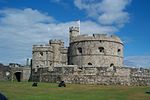SM UB-106

SM UB-106 was a German Type UB III submarine or U-boat in the German Imperial Navy (German: Kaiserliche Marine) during World War I. She was commissioned into the German Imperial Navy on 7 February 1918 as SM UB-104.UB-106 was lost in an accident on 15 March 1918, but was later raised and recommissioned. She was surrendered to the Allies at Harwich on 26 November 1918. After passing into British hands, UB-97 was towed to Falmouth along with five other U-boats for use in a series of explosive test trials by the Royal Navy in Falmouth Bay, in order to find weaknesses in their design. Following her use during 13/17 January 1921, UB-106 was dumped on Castle Beach and sold to R. Roskelly & Rodgers on 19 April 1921 for scrap (for £125), and partially salvaged over the following decades, although parts remain in situ.
Excerpt from the Wikipedia article SM UB-106 (License: CC BY-SA 3.0, Authors, Images).SM UB-106
Castle Drive,
Geographical coordinates (GPS) Address Nearby Places Show on map
Geographical coordinates (GPS)
| Latitude | Longitude |
|---|---|
| N 50.145675 ° | E -5.0501583333333 ° |
Address
Castle Drive
Castle Drive
TR11 4WZ
England, United Kingdom
Open on Google Maps








